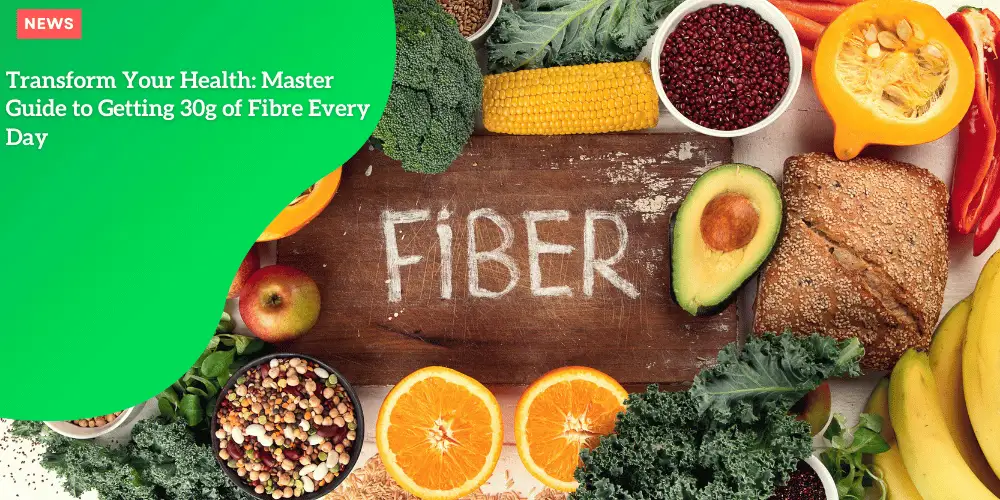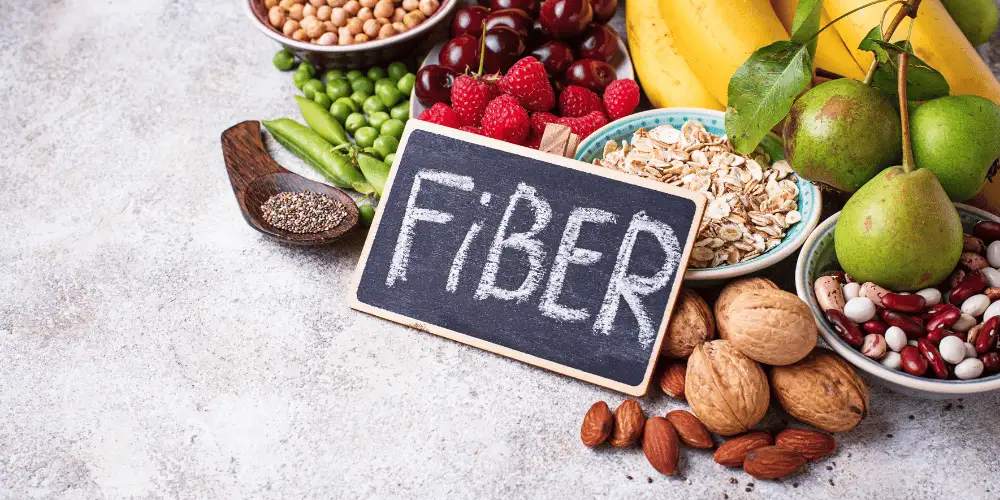Transform Your Health: Master Guide to Getting 30g of Fibre Every Day

Anúncios
Understanding Fibre: The Essential Nutrient
What is Fibre?
Fibre is a type of carbohydrate found in plant-based foods such as wholegrains, vegetables, fruits, nuts, seeds, herbs, spices, and legumes.
Unlike other carbohydrates, fibre isn’t easily broken down in the gut.
Anúncios
Instead, it travels through your digestive system, adding bulk and aiding in the regular movement of food through the intestines.
Although it’s often praised for preventing constipation, fibre’s benefits extend far beyond maintaining regularity.
Anúncios
Fibre’s Role in Disease Prevention
A diet rich in fibre is powerful in reducing the risk of major diseases.
According to a landmark study from 2019, a high-fibre diet can lower the risk of heart disease, stroke, type 2 diabetes, and colon cancer by 16-24%.
Notably, the UK’s Scientific Advisory Committee on Nutrition in 2015 found that each 7g increase in daily fibre intake can lower the risk of noncommunicable diseases by up to 9%.
Adding half a tin of baked beans, for instance, could have a significant impact on your health.
Different Types of Fibre
Fibre isn’t a single entity but an umbrella term that encompasses various types that have different roles in your body.
The two primary types of fibre are soluble and insoluble.
Soluble fibre dissolves in water and creates a gel-like substance, which helps lower glucose levels and blood cholesterol.
Insoluble fibre does not dissolve in water and aids in moving material through your digestive system, which is essential for preventing constipation.
Benefits of a Diverse Fibre Intake
Different types of fibre contribute to unique health benefits.
For example, some fibres act as prebiotics, feeding beneficial gut bacteria and promoting a healthy gut microbiome.
This microbial balance not only supports digestion but also has been linked to improved brain health and function.
Research shows that a healthy gut can potentially reduce symptoms of anxiety and depression.
How Much Fibre Do You Need?
Most health guidelines recommend a daily intake of around 30g of fibre.
However, many people fall short of this target. In the UK, for instance, the average daily intake hovers around 19g, with only 9% of the population meeting the recommended amount.
Adopting a varied diet rich in fibre can help bridge this gap and offer robust protection against various health issues.
Understanding the vast benefits of fibre can be the first step in making small, sustainable changes to your diet that could have enormous health benefits.
By incorporating a variety of fibre-rich foods, you can support not only your digestive system but also your overall well-being.

The Global Fibre Gap
It’s startling to discover that despite the well-known benefits of dietary fibre, many of us fall woefully short of the recommended daily intake.
In the UK, only 9% of the population meets the guideline of 30 grams per day, with the average intake hovering around 19 grams.
This shortfall isn’t just a UK issue—globally, many countries struggle to meet the mark.
For instance, only 3% of Canadians and 5% of Americans reach their respective fibre goals.
Why the Shortfall?
One major reason for this gap is the composition of modern diets, which are often high in salt, sugar, and fat, and low in fibre-rich foods like whole grains, fruits, and vegetables.
In a world where convenience and fast food reign supreme, fibre is frequently overlooked.
Additionally, there’s a prevailing misconception that starchy foods, which are excellent sources of fibre, are fattening, deterring people from consuming them.
The Impact on Health
This widespread deficiency has significant health ramifications.
Low fibre intake has been identified as a leading risk factor for diet-related illnesses, contributing to conditions such as heart disease, stroke, type 2 diabetes, and colon cancer.
Regular consumption of fibre, on the other hand, can reduce the risk of these diseases by 16-24%.
This is due to fibre’s role in aiding digestion, promoting a healthy gut microbiome, and regulating blood sugar levels.
Disparities and Success Stories
Interestingly, some countries have made successful strides in increasing fibre intake.
Denmark, for instance, implemented the Danish Whole Grain Partnership, a public-private initiative that significantly boosted whole grain consumption.
Between 2008 and 2019, Denmark saw a 128% increase in daily whole grain intake, with the percentage of the population meeting the recommended amount rising from 6% to 54%.
This unparalleled strategy could serve as a model for other nations struggling to close their own fibre gaps.
Moving Forward
Addressing the fibre gap necessitates a multifaceted approach.
Public awareness campaigns, policy changes, and individual dietary adjustments all play crucial roles.
Gradually increasing fibre intake to avoid side effects like bloating and discomfort is one practical step.
Drinking plenty of water and diversifying the types of fibre consumed are also essential for maximizing health benefits.
While the challenge is substantial, the benefits of meeting fibre intake guidelines are undeniable.
Understanding and addressing this global fibre gap could significantly enhance public health, making it a crucial priority for both individuals and policymakers alike.
Foundation of a High-Fibre Diet
Transitioning to a high-fibre diet can feel like a significant lifestyle change, but it’s easier when you break it down into practical steps.
The foundation of a high-fibre diet rests on the everyday choices you make in your kitchen and at the grocery store.
Let’s get to the basics of how to build your meals and snacks to reach that golden 30g of fibre a day.
Starchy Foods and Wholegrains
Start by basing all three of your daily meals on starchy foods.
This doesn’t mean indulging in refined products like white bread or white rice.
Instead, focus on wholegrains such as whole wheat bread, brown rice, oats, barley, and quinoa.
Wholegrains are powerhouses of fibre.
For instance, two slices of wholemeal bread can provide up to 5g of fibre, helping you edge closer to that daily goal.
Fruits and Vegetables
Next up, aim for at least eight portions of vegetables and fruit each day.
This might seem like a lot, but spreading these portions throughout the day makes it more manageable.
Vegetables like broccoli, brussels sprouts, and sweet potatoes are particularly high in fibre.
Fruits like berries, apples (with skins on), and pears are excellent choices, especially if you’re on the go.
Keep a variety of fresh, frozen, and tinned fruits and vegetables on hand to make reaching your fibre goals simpler and more variety-rich.
High-Fibre Snacks
Snacking between meals is another ideal opportunity to boost your fibre intake. Opt for high-fibre snacks such as:
- 🌰 Nuts and seeds: A handful of almonds or chia seeds can add a significant fibre boost.
- 🌾 Wholegrain crackers: Pair these with high-fibre dips like hummus.
- 🍓 Fresh fruit: Opt for fruits like apples or pears that you can easily eat with the skin on for extra fibre.
- 🫛 Veggie sticks with dips like hummus or guacamole are also great snacking options.
Smart Choices with Food
Being mindful of your choices and making smart swaps can be a game-changer.
Replace white bread with wholemeal, rye, or granary alternatives.
Instead of white rice and pasta, choose brown rice and whole wheat pasta.
When it comes to fruits, eat them whole rather than opting for fruit juices, which generally lack fibre.
Whenever possible, keep the skins on your fruits and vegetables, as they contain a good amount of fibre.
Hydration and Gradual Increase
As you increase your fibre intake, it’s crucial to also increase your water consumption.
Fibre works best when it absorbs water, helping to move it through your digestive system.
Start slow and gradually increase your fibre intake to avoid discomfort like bloating or gas.
Building a high-fibre diet is all about integrating these changes into your daily routine until they become second nature.
Not only will you feel fuller and more satisfied, but you’ll also be taking significant steps towards better overall health.
By focusing on these core principles, you’re well on your way to making fibre an essential part of your everyday diet.
This foundation sets you up not just for achieving your daily fibre goals, but also for enjoying the wide-ranging health benefits that come with it.
Smart Swaps for Higher Fibre
Bread and Grains
One of the simplest ways to boost your fibre intake is by swapping out refined grains for their whole-grain counterparts.
Instead of reaching for white bread, which offers minimal nutritional value, try wholemeal, rye, or granary bread.
These alternatives are packed with dietary fibre that supports digestion and promotes overall health.
Similarly, when it comes to other staples like rice and pasta, make the switch from white to brown rice and whole wheat pasta.
Not only are these options richer in fibre, but they also retain more nutrients compared to their white versions.
Fruits, Vegetables, and Their Skins
Opting for whole fruits over juices is another smart move for increasing fibre intake.
Fruit juices often lack the fibre found in the whole fruit, as the juicing process removes much of it.
Additionally, keeping the skins on fruits and vegetables whenever possible retains a significant portion of their fibre content.
For example, the skin of an apple or a potato contains essential fibre that aids in digestion.
Everyday Food Choices
Small changes in your everyday food choices can significantly impact your fibre intake.
For instance, replace your usual breakfast of white toast with jam with wholemeal toast topped with peanut butter and a handful of chia seeds.
This swap not only increases your fibre intake but also adds healthy fats and protein to your meal.
When cooking pasta dishes, choose whole wheat spaghetti instead of white.
Combine it with a tomato-based sauce rich in vegetables, or add some lentils for an extra fibre punch.
Similarly, when making rice dishes, choose brown rice and incorporate a variety of beans and legumes into the mix for added fibre and protein.
Snacks and Convenience Foods
Reinvent your snack game by choosing high-fibre options.
Instead of reaching for cookies or chips, opt for snacks like fresh fruit slices, nuts, seeds, or wholegrain crackers.
These choices provide satisfying crunch and flavor while contributing positively to your daily fibre goals.
Conclusion and Transition
By making these smart swaps, you’ll find that increasing your fibre intake can be both easy and delicious.
These small changes, integrated into your daily routine, can lead to significant health benefits over time.
Now that you’ve learned the importance of making smart swaps for higher fibre, let’s explore some practical tips for effectively implementing these changes in your everyday life.
Practical Tips for Implementation
Increase Fibre Intake Gradually
One of the most crucial steps to implementing a high-fibre diet is to increase your fibre intake gradually.
Changing your diet too quickly can lead to discomfort, bloating, and other digestive issues.
This is because fibre draws water into the bowel, and your digestive system needs time to adjust.
Start by slowly incorporating more fibre-rich foods into your meals and ramp up the quantity over a few weeks.
This gradual approach can help your body adapt, reducing the chances of adverse effects.
Drink Plenty of Water
Drinking enough water is essential when consuming a high-fibre diet.
Fibre absorbs water in the gut, which helps to soften stools and prevent constipation.
Without sufficient hydration, you may experience cramps or a feeling of fullness.
Aim to drink at least eight glasses of water daily to ensure that the increased fibre intake has a supportive environment to work in.
Read Food Labels for Fibre Content
Understanding food labels can significantly aid your efforts to boost fibre intake.
When shopping, look for products labeled as “high in fibre,” which means they contain at least 6 grams of fibre per 100 grams.
Another helpful label is “source of fibre,” which denotes at least 3 grams of fibre per 100 grams.
Being diligent about reading food labels helps you make informed choices without relying solely on raw ingredients.
Affordable Fibre Sources
Focusing on affordable sources of fibre is both cost-effective and practical.
Some budget-friendly options include potatoes, oats, lentils, and beans.
These foods are not only inexpensive but also versatile, fitting easily into various recipes and meals.
By integrating these into your diet, you can significantly ramp up your daily fibre intake without breaking the bank.
- 🥔 Potatoes: Keep the skins on when preparing dishes like baked potatoes, mashed potatoes, and home fries.
- 🥣 Oats: Incorporate oats into your breakfast routine with options like porridge, overnight oats, and smoothies.
- 🫘 Lentils and Beans: Use lentils and beans in soups, stews, and salads for a fibre boost.
Incorporating these tips into your daily routine can make reaching the recommended 30 grams of fibre a day achievable in a manageable and affordable manner.
Remember, small changes can make a significant impact over time.
Adopting a high-fibre diet not only benefits your digestive health but also reduces the risk of several lifestyle-related diseases.






